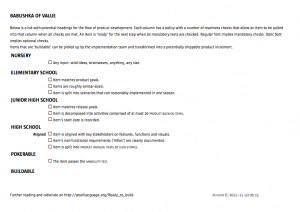Difference between revisions of "Babushka of value"
Jump to navigation
Jump to search
(Fix the process, not the people) |
(+Quality) |
||
| Line 1: | Line 1: | ||
{{Oyster | {{Oyster | ||
|stage=Sparkle | |stage=Sparkle | ||
|theme=Agile, Lean | |theme=Agile, Lean, Quality | ||
|context=product development, in the broadest sense. | |context=product development, in the broadest sense. | ||
|wish in a single line=You want a sustainable, ever evolving flow of value creating activities. | |wish in a single line=You want a sustainable, ever evolving flow of value creating activities. | ||
Revision as of 14:12, 12 December 2012
…product development, in the broadest sense.
✣ ✣ ✣
{{{wish full}}}
Goals:
- maximize flow
- minimize transitions and boundaries—only introduce them when absolutely necessary
- maximum cohesion, minimal coupling (and dependancies)
Design Principles:
- done for upstream equals ready for downstream
- downstream defines interface for upstream in collaboration with upstream
Therefore:
{{{therefore full}}}
✣ ✣ ✣
In short:
- Fix the process, not the people.
Each maturity level includes and transcends all previous levels, just like a babushka doll.
✣ ✣ ✣
PDF with example on the right.
Forces:
- flow to ready
- sprint to done
- ready for downstream equals done for upstream
Metaphore unto ready to build is the school system: Nursery School → Elementary School → High School → University.
In the right conditions and within constraints, items develop, unfold, mature in every phase until they are ready for the next. Items ready for the next phase are done in the current.
|
Nursery School |
Elementary School |
Junior High School |
University |
Ready to Poker |
Read to Build |
Ready to Ship | |
|---|---|---|---|---|---|---|---|
|
Policy |
|
|
|
|
|
|
ready to ship, a.k.a. definition of done. |
|
Activities |
|
|
|
|
|
|
|

